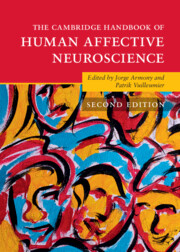Book contents
- The Cambridge Handbook of Human Affective Neuroscience
- Cambridge Handbooks in Psychology
- The Cambridge Handbook of Human Affective Neuroscience
- Copyright page
- Contents
- Figures
- Tables
- Contributors
- Introduction
- Section I Theoretical Models of Emotion
- Section II Measuring Emotional Processes
- Section III Emotion Perception and Elicitation
- Section IV Emotional Learning and Memory
- Chapter 16 Conditioned Fear Learning
- Chapter 17 Reward Learning in a Social World
- Chapter 18 Episodic Emotional Memory
- Section V Cognition–Emotion Interactions
- Section VI Social Emotions
- Section VII Individual Differences
- Index
- References
Chapter 17 - Reward Learning in a Social World
from Section IV - Emotional Learning and Memory
Published online by Cambridge University Press: 16 September 2025
- The Cambridge Handbook of Human Affective Neuroscience
- Cambridge Handbooks in Psychology
- The Cambridge Handbook of Human Affective Neuroscience
- Copyright page
- Contents
- Figures
- Tables
- Contributors
- Introduction
- Section I Theoretical Models of Emotion
- Section II Measuring Emotional Processes
- Section III Emotion Perception and Elicitation
- Section IV Emotional Learning and Memory
- Chapter 16 Conditioned Fear Learning
- Chapter 17 Reward Learning in a Social World
- Chapter 18 Episodic Emotional Memory
- Section V Cognition–Emotion Interactions
- Section VI Social Emotions
- Section VII Individual Differences
- Index
- References
Summary
Humans are inherently social beings, driven by a fundamental need to belong. To fulfill this need for social connection, neural circuits of reward processing are co-opted to value social rewards derived from social interactions. These circuits play a critical role in our pursuit of social relationships, enabling us to learn about others and strengthen connections. In this chapter, we delve into basic reward circuitry that facilitates social learning, and how such circuitry supports brain networks involved in unique social phenomena, such as theory of mind and empathy. We then explore how this understanding of neural mechanisms informs decision-making in complex social situations. Furthermore, we discuss how research into rewarding social outcomes can shed light on coping mechanisms for challenges such as isolation and pervasive social media use. By examining the interplay between our social nature and neural processes, we gain insight into navigating the complexities of human interaction and well-being.
Information
- Type
- Chapter
- Information
- The Cambridge Handbook of Human Affective Neuroscience , pp. 346 - 362Publisher: Cambridge University PressPrint publication year: 2025
References
Accessibility standard: WCAG 2.0 A
Why this information is here
This section outlines the accessibility features of this content - including support for screen readers, full keyboard navigation and high-contrast display options. This may not be relevant for you.Accessibility Information
Content Navigation
Allows you to navigate directly to chapters, sections, or non‐text items through a linked table of contents, reducing the need for extensive scrolling.
Provides an interactive index, letting you go straight to where a term or subject appears in the text without manual searching.
Reading Order & Textual Equivalents
You will encounter all content (including footnotes, captions, etc.) in a clear, sequential flow, making it easier to follow with assistive tools like screen readers.
You get concise descriptions (for images, charts, or media clips), ensuring you do not miss crucial information when visual or audio elements are not accessible.
You get more than just short alt text: you have comprehensive text equivalents, transcripts, captions, or audio descriptions for substantial non‐text content, which is especially helpful for complex visuals or multimedia.
Visual Accessibility
You benefit from high‐contrast text, which improves legibility if you have low vision or if you are reading in less‐than‐ideal lighting conditions.
Structural and Technical Features
You gain clarity from ARIA (Accessible Rich Internet Applications) roles and attributes, as they help assistive technologies interpret how each part of the content functions.
